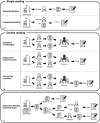Deep Learning-Based Artificial Intelligence for Mammography
- PMID: 33987993
- PMCID: PMC8316774
- DOI: 10.3348/kjr.2020.1210
Deep Learning-Based Artificial Intelligence for Mammography
Abstract
During the past decade, researchers have investigated the use of computer-aided mammography interpretation. With the application of deep learning technology, artificial intelligence (AI)-based algorithms for mammography have shown promising results in the quantitative assessment of parenchymal density, detection and diagnosis of breast cancer, and prediction of breast cancer risk, enabling more precise patient management. AI-based algorithms may also enhance the efficiency of the interpretation workflow by reducing both the workload and interpretation time. However, more in-depth investigation is required to conclusively prove the effectiveness of AI-based algorithms. This review article discusses how AI algorithms can be applied to mammography interpretation as well as the current challenges in its implementation in real-world practice.
Keywords: Artificial intelligence; Breast cancer; Computer-aided diagnosis; Deep learning; Mammography.
Copyright © 2021 The Korean Society of Radiology.
Conflict of interest statement
The authors have no potential conflicts of interest to disclose.
Figures



References
-
- World Health Organization. IARC handbooks. Breast cancer screening. Volume 15. Lyon: International Agency for Research on Cancer; 2015.
-
- Myers ER, Moorman P, Gierisch JM, Havrilesky LJ, Grimm LJ, Ghate S, et al. Benefits and harms of breast cancer screening: a systematic review. JAMA. 2015;314:1615–1634. - PubMed
-
- Lauby-Secretan B, Scoccianti C, Loomis D, Benbrahim-Tallaa L, Bouvard V, Bianchini F, et al. Breast-cancer screening--viewpoint of the IARC Working Group. N Engl J Med. 2015;372:2353–2358. - PubMed
-
- Houssami N, Lee CI, Buist DSM, Tao D. Artificial intelligence for breast cancer screening: opportunity or hype? Breast. 2017;36:31–33. - PubMed
Publication types
MeSH terms
LinkOut - more resources
Full Text Sources
Other Literature Sources
Medical
Miscellaneous

